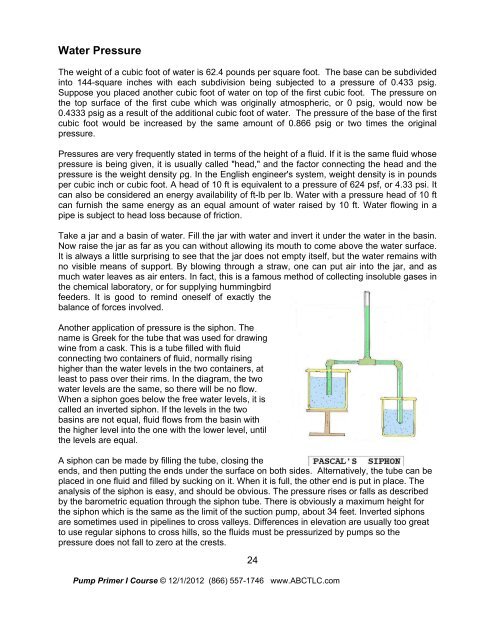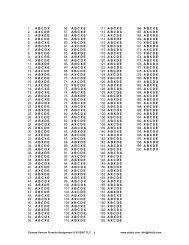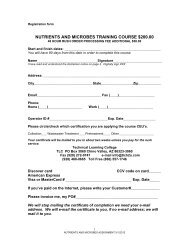Pump Primer 1 $100 - 8 Hours - Technical Learning College
Pump Primer 1 $100 - 8 Hours - Technical Learning College
Pump Primer 1 $100 - 8 Hours - Technical Learning College
You also want an ePaper? Increase the reach of your titles
YUMPU automatically turns print PDFs into web optimized ePapers that Google loves.
Water Pressure<br />
The weight of a cubic foot of water is 62.4 pounds per square foot. The base can be subdivided<br />
into 144-square inches with each subdivision being subjected to a pressure of 0.433 psig.<br />
Suppose you placed another cubic foot of water on top of the first cubic foot. The pressure on<br />
the top surface of the first cube which was originally atmospheric, or 0 psig, would now be<br />
0.4333 psig as a result of the additional cubic foot of water. The pressure of the base of the first<br />
cubic foot would be increased by the same amount of 0.866 psig or two times the original<br />
pressure.<br />
Pressures are very frequently stated in terms of the height of a fluid. If it is the same fluid whose<br />
pressure is being given, it is usually called "head," and the factor connecting the head and the<br />
pressure is the weight density ρg. In the English engineer's system, weight density is in pounds<br />
per cubic inch or cubic foot. A head of 10 ft is equivalent to a pressure of 624 psf, or 4.33 psi. It<br />
can also be considered an energy availability of ft-lb per lb. Water with a pressure head of 10 ft<br />
can furnish the same energy as an equal amount of water raised by 10 ft. Water flowing in a<br />
pipe is subject to head loss because of friction.<br />
Take a jar and a basin of water. Fill the jar with water and invert it under the water in the basin.<br />
Now raise the jar as far as you can without allowing its mouth to come above the water surface.<br />
It is always a little surprising to see that the jar does not empty itself, but the water remains with<br />
no visible means of support. By blowing through a straw, one can put air into the jar, and as<br />
much water leaves as air enters. In fact, this is a famous method of collecting insoluble gases in<br />
the chemical laboratory, or for supplying hummingbird<br />
feeders. It is good to remind oneself of exactly the<br />
balance of forces involved.<br />
Another application of pressure is the siphon. The<br />
name is Greek for the tube that was used for drawing<br />
wine from a cask. This is a tube filled with fluid<br />
connecting two containers of fluid, normally rising<br />
higher than the water levels in the two containers, at<br />
least to pass over their rims. In the diagram, the two<br />
water levels are the same, so there will be no flow.<br />
When a siphon goes below the free water levels, it is<br />
called an inverted siphon. If the levels in the two<br />
basins are not equal, fluid flows from the basin with<br />
the higher level into the one with the lower level, until<br />
the levels are equal.<br />
A siphon can be made by filling the tube, closing the<br />
ends, and then putting the ends under the surface on both sides. Alternatively, the tube can be<br />
placed in one fluid and filled by sucking on it. When it is full, the other end is put in place. The<br />
analysis of the siphon is easy, and should be obvious. The pressure rises or falls as described<br />
by the barometric equation through the siphon tube. There is obviously a maximum height for<br />
the siphon which is the same as the limit of the suction pump, about 34 feet. Inverted siphons<br />
are sometimes used in pipelines to cross valleys. Differences in elevation are usually too great<br />
to use regular siphons to cross hills, so the fluids must be pressurized by pumps so the<br />
pressure does not fall to zero at the crests.<br />
<strong>Pump</strong> <strong>Primer</strong> I Course © 12/1/2012 (866) 557-1746 www.ABCTLC.com<br />
24
















